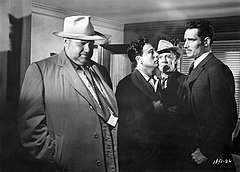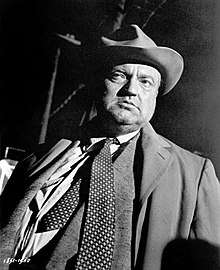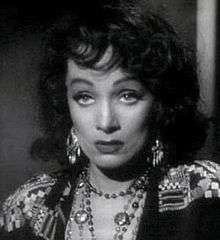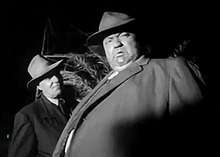Touch of Evil
Touch of Evil is a 1958 American film noir written, directed by, and co-starring Orson Welles. The screenplay was loosely based on the contemporary Whit Masterson novel Badge of Evil (1956). Along with Welles, the cast included Charlton Heston, Janet Leigh, Joseph Calleia, Akim Tamiroff, and Marlene Dietrich.
| Touch of Evil | |
|---|---|
.jpg) Theatrical release poster | |
| Directed by | Orson Welles |
| Produced by | Albert Zugsmith |
| Screenplay by | Orson Welles |
| Based on | Badge of Evil by Whit Masterson |
| Starring | |
| Music by | Henry Mancini |
| Cinematography | Russell Metty |
| Edited by |
|
Production company | Universal International |
| Distributed by | Universal International |
Release date |
|
Running time | 111 minutes (1998 version)[1] |
| Country | United States |
| Language | English |
| Budget | $829,000 |
| Box office | $2.2 million[2][3] 1,232,534 admissions (France)[4] |
One of the last examples of film noir in the genre's classic period,[5] its reputation has grown since its release, and it is now widely regarded as one of Welles's best motion pictures and one of the best classic-era films noir.
In 1993, the film was selected for preservation in the United States National Film Registry by the Library of Congress as being "culturally, historically, or aesthetically significant".[6][7][8]
Plot
In Los Robles, a Mexican town along the U.S.–Mexico border, a time bomb is planted in a car. Rudy Linnekar (Jeffrey Green) and Zita (Joi Lansing) enter the vehicle and make a slow journey through town to the U.S. border, during which Zita insists that she can hear something ticking. Newlyweds Miguel "Mike" Vargas (Charlton Heston), a drug enforcement official in the Mexican government, and his wife Susie (Janet Leigh) pass the car several times on foot. The car crosses the border, then explodes. Realizing the implications of a Mexican bomb exploding on American soil, Vargas takes an interest in the investigation. Police Chief Pete Gould (Harry Shannon) and District Attorney Adair (Ray Collins) arrive on the scene, followed by the game-legged police captain Hank Quinlan (Orson Welles) and Quinlan's longtime partner, Pete Menzies (Joseph Calleia)—who clearly worships Quinlan. The obese and disheveled Captain nostalgically visits a brothel run by Tanya (Marlene Dietrich), who barely recognizes him because he's gained so much weight.
Quinlan's and Menzies' prime suspect is Sanchez, a young Mexican secretly married to the victim's daughter (Joanna Moore). They interrogate Sanchez in his apartment with Vargas present. Vargas visits the bathroom and accidentally knocks over an empty shoebox. Moments later, Menzies enters the bathroom and announces that two sticks of dynamite were found in the same shoebox. Vargas accuses Quinlan of planting the evidence and begins to suspect that he may have been doing so for years, to help win convictions. Quinlan dismisses Vargas's claim, saying he is just biased in favor of fellow Mexicans. The stress of these accusations, along with pressure from "Uncle" Joe Grandi (Akim Tamiroff), the brother of a man Vargas has been investigating, to strike a deal to discredit Vargas, causes Quinlan—who has been sober for 12 years—to fall off the wagon. With assistance from District Attorney's Assistant Al Schwartz (Mort Mills), Vargas studies the public records on Quinlan's previous cases, revealing his findings to Gould and Adair. Quinlan arrives in time to overhear the discussion and angrily threatens to resign.
Susie Vargas moves from her Mexican hotel to a remote American motel to escape the unwanted attention of Grandi. The motel, which Menzies recommended to her, has no other guests and is staffed only by a very peculiar night manager (Dennis Weaver), and, unknown to Susie, is owned by Grandi himself. Grandi's family members take over the motel and terrorize Susie. Vargas becomes concerned when his attempts to telephone Susie at the motel are blocked. Quinlan conspires with Grandi, arranging for Susie to be knocked unconscious, kidnapped, and made to look like she had overdosed on drugs by placing drugs around her unconscious body. Quinlan then double-crosses Grandi, strangles him, and leaves Susie, still unconscious, in the room with Grandi's body, all in order to discredit Vargas. However, exhausted, drunk, and shaken from killing Grandi, Quinlan carelessly leaves his cane at the scene of the murder, implicating himself. When Susie wakes up, she sees Grandi's dead body, screams for help, and is arrested on suspicion of murder.
Vargas confronts Menzies about the history of evidence "discovered" by Quinlan. When he goes to Susie's motel, but cannot find her, Vargas learns the motel is owned by Grandi, and that his handgun has been stolen. He rushes back to town and enters a bar, where he confronts the gang members who attacked his wife. When they refuse to answer his questions, Vargas violently beats them down, destroying the bar in the process. Schwartz then informs a shocked Vargas that Susie has been arrested for murder. At the lockup, Vargas finds her barely conscious. Menzies reveals to Vargas that he discovered Quinlan's cane at the murder scene. Vargas fits Menzies with a wire. Quinlan is at Tanya's brothel, where he asks her to use her tarot cards to tell his future; she tells him that he has no future. A loud player piano prevents recording, so Menzies lures Quinlan out to "talk". They walk to a nearby oil field while being tracked on foot by Vargas, who is carrying a recorder and taping the conversation.
Quinlan admits to Menzies that he planted evidence on people, but insists that he did so only because he knew they were guilty. Quinlan hears an echo from the secret microphone and says his "game leg" has informed him of Menzies' betrayal. Quinlan demands that Vargas show himself. Quinlan then shoots Menzies with Vargas's gun, which he had earlier stolen from Vargas's briefcase. Quinlan prepares to shoot Vargas but is, instead, shot by the dying Menzies. Quinlan staggers backwards into a filthy pool of wastewater and dies. Schwartz arrives at the scene and tells Vargas that the planted dynamite was unnecessary because Sanchez confessed to the crime. Vargas is reunited with Susie, having been exonerated from prison after evidence of Quinlan's confession was found. Tanya finds Quinlan in the wastewater and is asked by Schwartz about what she has to say about Quinlan. Tanya replies, "He was some kind of a man. What does it matter what you say about people?" Tanya then walks away as the movie ends.
Cast
- Charlton Heston as Ramon Miguel Vargas
- Janet Leigh as Susan Vargas
- Orson Welles as Police Captain Hank Quinlan
- Joseph Calleia as Pete Menzies
- Akim Tamiroff as Uncle Joe Grandi
- Joanna Cook Moore as Marcia Linnekar
- Ray Collins as District Attorney Adair
- Dennis Weaver as the Night Manager
- Val de Vargas as Pancho
- Mort Mills as Al Schwartz
- Victor Millan as Manolo Sanchez
- Lalo Rios as Risto
- Phil Harvey as Blaine
- Joi Lansing as Zita
- Harry Shannon as Police Chief Pete Gould
- Rusty Wescoatt as Casey
- Wayne Taylor as a gang member
- Ken Miller as a gang member
- Raymond Rodriguez as a gang member
- Arlene McQuade as Ginnie
- Dan White as the Border Guard
- Zsa Zsa Gabor as the Strip-club owner
- Marlene Dietrich as Tanya
- Mercedes McCambridge as a hoodlum
- William Tannen as Howard Frantz
- Joseph Cotten (uncredited) as a coroner
Production
Two stories have been told about how Welles ended up directing Touch of Evil. In one story, Charlton Heston recalled that Welles was originally hired to act in the film only, not to direct or write. Universal was keen to secure Heston for the lead, but he wanted the studio to confirm the director before he signed on. After learning that Welles was in the cast, Heston expressed his greater interest in starring if Welles were directing.
The other story is that Welles had recently worked with producer Albert Zugsmith, known as the "King of the Bs", on a film called Man in the Shadow, and that he was interested in directing something for him. Zugsmith offered him a pile of scripts, of which Welles asked for the worst to prove he could make a great film out of a bad script. At the time, the script was called Badge of Evil, after a Whit Masterson novel on which it was based. Welles did a rewrite and took it into production. After a decade in Europe during which he completed only a few films, Welles was eager to direct for Hollywood again, so he agreed to take only an acting fee for the role of Quinlan.[9][10]
A number of notable actors pop up in roles. Dennis Weaver plays a night clerk at a motel; Heston liked Weaver and his film acting work. Zsa Zsa Gabor, who appears briefly as the impresario of a strip club, was a friend of the producer. Joseph Calleia portrays Quinlan's betrayed partner. Many of the actors worked for lower wages just to make a film with Welles. Marlene Dietrich's role was a surprise to the producers and they raised her fee so they could advertise her involvement. Welles's friend and Mercury Theatre colleague Joseph Cotten appears uncredited as a coroner.
Janet Leigh recalled how Welles asked for input from the actors in the cast:
"It started with rehearsals. We rehearsed two weeks prior to shooting, which was unusual. We rewrote most of the dialogue, all of us, which was also unusual, and Mr. Welles always wanted our input. It was a collective effort, and there was such a surge of participation, of creativity, of energy. You could feel the pulse growing as we rehearsed. "You felt you were inventing something as you went along. Mr. Welles wanted to seize every moment. He didn't want one bland moment. He made you feel you were involved in a wonderful event that was happening before your eyes."[11]
Welles wrapped production on time, delivered a rough cut to Universal, and was convinced that his Hollywood career was back on the rails. However, the film was then re-edited (and in part re-shot) by Universal International pictures. The editing process was protracted and disputed, and the version eventually released was not the film Universal or Welles had hoped for. It was released as a B-movie, the lower half of a double feature. The A-movie was The Female Animal, starring Hedy Lamarr, produced by Albert Zugsmith and directed by Harry Keller, whom the studio had hired to direct the re-shot material in Touch of Evil. The two films even had the same cameraman, Russell Metty. Welles's film was given little publicity despite the many stars in the cast. Although it had little commercial success in the US (Welles himself claimed that the movie turned a good profit but other records disputed his claim), it was well received in Europe, particularly by critics like future filmmaker François Truffaut.
The film opens with a single uninterrupted tracking shot lasting three minutes and twenty seconds; it is widely considered by critics as one of the greatest long takes in cinema history.[12][13]
Versions
Three versions of the film have been released:[14]
- The original 1958 release (93 minutes). This version differed substantially from Welles's original cut, both in the editing and in the addition of new scenes directed by Harry Keller.
- A 108-minute version released in 1976 that incorporated material cut from the 1958 release.
- A 111-minute version released in 1998 that implemented Welles's notes from his long memo to the studio. Welles wrote this memo in December 1957 after viewing a version incorporating Keller's scenes, and that had been edited without Welles's participation.[15]
1958 release
Welles's rough cut as submitted to Universal no longer exists. That cut was worked on and trimmed down by Universal staff, and in late 1957 Universal decided to perform some reshoots. Welles claimed these were done without his knowledge, but Universal claimed that Welles ignored the studio's requests to return and undertake further work. It was at this point that Keller came aboard: some of his material was entirely new, others replaced Welles's scenes. Welles screened the new cut and wrote a 58-page memo to Universal's head of production, Edward Muhl, detailing what he thought needed to be done to make the film work. However, many of his suggestions went unheeded and Touch of Evil was eventually released in a version running 93 minutes.
A 1957 Variety review of the movie starts, "Touch of Evil smacks of brilliance but ultimately flounders in it."[16]
1976 release
In the mid-1970s, Universal discovered that it held a 108-minute print of Touch of Evil in its archives. Aware that there was a growing audience of cineastes with a strong interest in Welles's work, the studio released this version to cinemas in 1976 and later issued it on video, billing it as "complete, uncut and restored". In fact, this print was not a restoration at all, but a preview version which post-dated the Welles memo but pre-dated the release version. While it did feature some vital Welles scenes that Universal cut from the release version, the preview version also featured more of Keller's material than the release version.
1998 release
In 1998, Walter Murch, working from all available material, re-edited the film based on the Welles memo, with Rick Schmidlin who produced the re-edit and with the help of Bob O'Neil, Universal's director of film restoration, and Bill Varney, Universal's Vice President of Sound Operations, participating in the restoration.[17][18] As Welles's rough cut no longer exists, no true "director's cut" is possible, but Murch was able to assemble a version incorporating most of the existing material, omitting some of the Keller scenes (though some were retained, either because they had replaced Welles scenes which no longer existed and were necessary to the plot, or because Welles had approved of their inclusion). In addition, some of Welles's complaints concerned subtle sound and editing choices, and Murch re-edited the material accordingly.[19] Notable changes include the removal of the credits and Henry Mancini's music from the opening sequence, cross-cutting between the main story and Janet Leigh's subplot, and the removal of Harry Keller's hotel lobby scene. Rick Schmidlin produced the 1998 edit, which had a limited but successful theatrical release (again by Universal) and was subsequently made available on DVD. The DVD includes an on-screen reproduction of the 58-page memo.
Originally scheduled to be premiered at the 1998 Cannes Film Festival with Janet Leigh, Walter Murch and Rick Schmidlin attending, the screening was canceled at the eleventh hour after threats of litigation from Welles's daughter, Beatrice Welles. Her suit against Universal, for not consulting her or obtaining her consent prior to the reworking of Touch of Evil, was settled out of court.[20] Welles later said she had only asked Universal to inform her on what was being done, and when she was ignored she told the Cannes Festival that the restoration was not sanctioned by the Welles Estate:
"I saw it later and it was wonderful...I thought they did an amazing job and it was very well done. It was what he wanted and it made much more sense than that chopped up nightmare there was before. It was fine and it was his. If they had told me that from the very beginning, none of that would have happened."[21]
The film was first released on Blu-ray in 2011 in the UK by Eureka Entertainment (under licence from Universal) as part of their Masters of Cinema series. This release collected all three available versions, but in addition to that the theatrical and reconstruction versions include an alternate 1.37:1 ratio opposed to the original 1.85:1 aspect ratio (which is also included for both versions).[22] Eventually in the US, all three versions (in only their 1.85:1 aspect ratio) were released on Blu-ray by Universal in 2014, with a remastered transfer and with a limited edition version including a booklet of the original 58-page memo.[23] A more commercially available version was released a year later in 2015.[24]
Accolades
Although Universal Pictures did its best to prevent Touch of Evil from being selected for the 1958 Brussels World Film Festival—part of the Expo 58 world's fair—the film received its European premiere and Welles was invited to attend. To his astonishment,[25] Welles collected the two top awards. Touch of Evil received the International Critics Prize, and Welles was recognized for his body of work.[26][27]
Touch of Evil was placed #64 on American Film Institute's "100 Years, 100 Thrills" list in 2001.[28]
Roger Ebert added Touch of Evil to his Great Movies list in 1998. He praised the lead and supporting actors, and argued that the cinematography was "not simply showing off" but rather was used to add depth to the complex plot by showing interpersonal connections and "trapping [the characters] in the same shots". Ebert also speculated Welles's role was semi-autobiographical, describing his Quinlan character as nursing old feuds and demonstrating an obsessive desire for control that arguably parallels Welles's life and career.[29]
In the Sight & Sound Greatest Films of All Time 2012 poll, the film was placed #26 and #57 by the directors and the critics respectively.[30]
The 1998 re-edit received awards from the New York Film Critics Circle, the Los Angeles Film Critics Association and National Society of Film Critics.
See also
References
- "Touch of Evil (re-issue)". Variety. Retrieved 2 July 2018.
- Box Office Information for Touch of Evil. The Numbers. Retrieved January 30, 2013.
- "TMe: Box Office Tops from 1950-1959". www.teako170.com.
- Orson Welles box office information in France at Box Office Story
- Tim Dirks, Film Noir, AMC Filmsite, http://www.filmsite.org/filmnoir.html
- "Complete National Film Registry Listing". National Film Registry. National Film Preservation Board. Retrieved 2015-11-12.
- "Frequently Asked Questions". National Film Registry. National Film Preservation Board. Retrieved 2015-11-12.
- "Librarian Announces National Film Registry Selections (March 7, 1994) - Library of Congress Information Bulletin". www.loc.gov. Retrieved 2020-05-13.
- Robson, Eddie, Film Noir, Virgin Books, 2005.
- Leaming, Barbara, Orson Welles: A Biography. New York: Viking Penguin Inc., 1985.
- Bernard Weinraub (18 September 1998). "Dark Secrets Of Suburbia". New York Times. Retrieved 2008-05-22.
- Alan Bacchus; The Long Take, Daily Film Dose, May 4, 2007; http://www.dailyfilmdose.com/2007/05/long-take.html
- Kiang, Jessica. "Ranking The 20 Greatest, Most Celebrated Long Takes | IndieWire". www.indiewire.com. Retrieved 2017-07-14.
- French, Lawrence. "Scenes Cut, Changed, or Transposed in Touch of Evil". Wellesnet. Retrieved 2020-06-10.
- Welles, Orson. "Memo From Orson Welles, December 5, 1957". wellesnet.com. Lawrence French (introduction and commentary).
- Staff, Variety (1957-12-31). "Touch of Evil". Variety. Retrieved 2019-07-19.
- Nelson, Valerie J. (2011-04-07). "Bill Varney dies at 77; Oscar-winning sound mixer". Los Angeles Times. Retrieved 2011-04-10.
- Taylor, Charles (10 September 1998). "Ballad of a fat man". Salon.com. Archived from the original on 2007-12-04. Retrieved 2008-05-22.
- Murch, Walter (6 September 1998). "Restoring the Touch Of Genius to a Classic". New York Times. Retrieved 2008-05-22.
- Macnab, Geoffrey (29 August 2003). "One of our classics is missing". The Guardian. London. Retrieved 2006-08-19.
- Kelly, Ray (2014-04-01). "Beatrice Welles interview". Wellesnet. Retrieved 2015-11-13.
- Touch of Evil Blu-ray, retrieved 2019-06-23
- Touch of Evil Blu-ray, retrieved 2019-06-23
- Touch of Evil Blu-ray, retrieved 2019-06-23
- Callow, Simon (2015). Orson Welles: One-Man Band. New York: Viking. p. 277. ISBN 978-0-670-02491-9.
- "1958 Brussels World Film Festival". International Federation of Film Critics (FIPRESCI). Retrieved 2018-05-15.
- Lyons, Leonard (July 10, 1958). "The Lyons Den". The Salt Lake Tribune.
- "AFI's 100 Years...100 Thrills". American Film Institute. Retrieved 2015-11-12.
- "Touch of Evil Movie Review". Roger Ebert. Retrieved 2017-08-26.
- "Votes for Touch of Evil (1958)". British Film Institute. Retrieved 2017-08-26.
Bibliography
- Comito, Terry, ed. (1985). Touch of Evil. Orson Welles, director. New Brunswick, NJ: Rutgers University Press. ISBN 0813510961.
- Nericcio, William Anthony (2007). "Hallucinations of Miscegenation and Murder: Dancing along the Mestiza/o Borders of Proto-Chicana/o Cinema with Orson Welles's Touch of Evil". Tex(t)-Mex: Seductive Hallucinations of the "Mexican" in America. University of Texas Press. ISBN 9780292714571. Book chapter on Orson Welles and Touch of Evil.
External links
| Wikimedia Commons has media related to Touch of Evil (1958 film). |
| Wikiquote has quotations related to: Touch of Evil |
- Touch of Evil essay by Michael Sragow at National Film Registry
- Touch of Evil essay by Daniel Eagan in America's Film Legacy: The Authoritative Guide to the Landmark Movies in the National Film Registry America's Film Legacy: The Authoritative Guide to the Landmark Movies in the National Film Registry, A&C Black, 2010 ISBN 0826429777, pages 544-546
- Touch of Evil on IMDb
- Touch of Evil at AllMovie
- Touch of Evil at the TCM Movie Database
- Touch of Evil at the American Film Institute Catalog
- Touch of Evil at Box Office Mojo
- Touch of Evil at Rotten Tomatoes
- Touch of Evil at Metacritic
- Text of Welles's 58-page memo to Universal Studios
- Touch of Genius, Charlton Heston's account of the production of Touch of Evil.
- Literature on Touch of Evil


_set_1.jpg)

